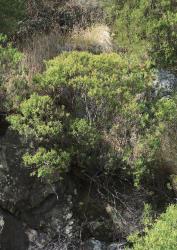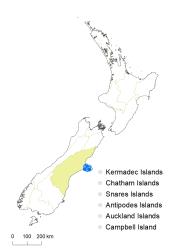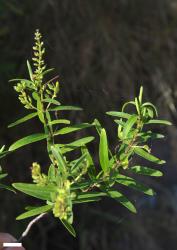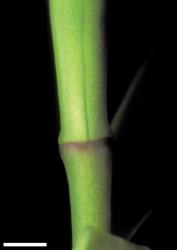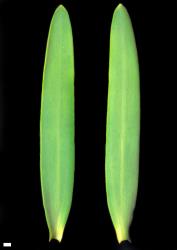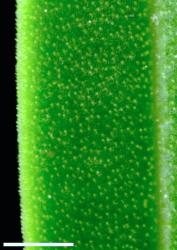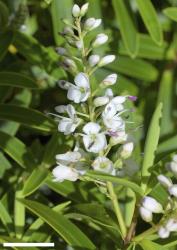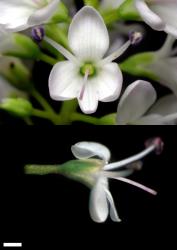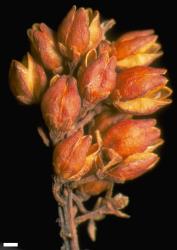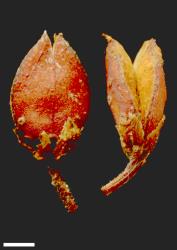- ≡ Veronica parviflora var. strictissima Kirk, Trans. New Zealand Inst. 28: 527 (1896)
- ≡ Veronica leiophylla var. strictissima (Kirk) Cockayne, Cawthron Lecture 3, 11 (1920)
- ≡ Hebe leiophylla var. strictissima (Kirk) Cockayne & Allan, Trans. New Zealand Inst. 57: 24 (1926)
- ≡ Hebe strictissima (Kirk) L.B.Moore in Allan, Fl. New Zealand 1, 916 (1961)
Bushy shrub to 2.5 m tall. Stems erect, eglandular-puberulent or glabrous, hairs bifarious. Leaf bud distinct, its leaves appressed at margins until fully grown; sinus absent. Leaves opposite-decussate, erecto-patent to spreading; lamina sub-coriaceous, linear, linear-lanceolate or narrowly oblong, 9–49 mm long, 3–8 mm wide, dull, green above, pale green beneath; midrib evident and two lateral veins sometimes evident; surfaces glabrous or with eglandular hairs along midrib above; margin glabrous or minutely papillate to minutely eglandular-hairy, entire; apex sub-acute to acute or shortly plicate-acuminate; petiole indistinct, broadly winged, 1–3 mm long. Inflorescence a lateral raceme, 17–107 mm long; flowers crowded, 11–72, female or bisexual on separate plants, ⚥ > ♀; bracts alternate, ovate or deltoid to narrowly deltoid, < pedicels; pedicels spreading, 1–4 mm long, short eglandular-hairy, sometimes sparsely, in one row or all around. Calyx lobes 4, obtuse to rounded, 1.2–1.5 mm long, sub-equal, mixed glandular- and eglandular-ciliolate, sometimes sparsely. Corolla 4.0–6.5 mm diameter; tube white, 1.4–2.9 mm long, = or slightly > calyx, eglandular-hairy inside; lobes 4, white or sometimes pale purplish, spreading to recurved, unequal, elliptic, ovate, or orbicular, 2.0–3.2 mm long, obtuse to rounded, posterior sometimes emarginate; nectar guides absent. Stamen filaments white, 3–5 mm long; anthers dark magenta or purple. Style glabrous or sometimes eglandular-hairy, 2.3–6.0 mm long. Capsules latiseptate, sub-acute to obtuse, usually glabrous or occasionally eglandular-hairy, 2.9–4.0 mm long, 2.2–2.6 mm at widest point. Seeds broadly ellipsoid, flattened, smooth, brown, 1.0–1.6 mm long.
parviflora | stenophylla | strictissima | traversii | |
|---|---|---|---|---|
Habit | shrub or small tree up to 12 m tall | shrub to 2 m tall, sometimes sprawling | rounded shrub to 2 m tall | shrub to 2.5 m tall |
Leaf length (mm) | 8–76 | 16–87 | 9–49 | 16–44 |
Leaf width (mm) | 1.5–7.0 | 2.5–10.0 | 3.0–8.0 | 2.5–9.0 |
Leaf margin | minutely hairy | glabrous, or occasionally pubescent | glabrous, papillate, or with very short, antrorse, tapered, eglandular hairs | scabrous, ciliate or pubescent |
Leaf adaxial (upper) surface | smooth | minutely pitted, especially near margins; each pit with a minute glandular hair | smooth | smooth |
Calyx lobes | mixed eglandular- and glandular-ciliate; the glandular hairs with 2 terminal cells | usually eglandular-ciliate; if also glandular, the glandular hairs mostly with 1 terminal cell; hairs with 2 terminal cells rare | mixed eglandular- and glandular-ciliolate, sometimes sparsely so; the glandular hairs with 2 terminal cells | eglandular-ciliolate or mixed eglandular- and glandular-ciliolate; glandular hairs with 2 terminal cells |
Corolla tube | up to 2 × calyx; > corolla lobes | 2–4 × calyx; > corolla lobes | = or slightly > calyx; < corolla lobes | 3–4 × calyx; > corolla lobes |
Corolla tube | hairy inside | usually glabrous; sometimes hairy (especially var. hesperia from NW Nelson) | hairy inside | hairy inside |
Capsule | c. 2 × calyx | c. 2 × calyx | c. 3 × calyx | 3–4 × calyx |
Distribution | North Island, mostly in the east; South Island (coastal Marlborough only) | central and east North Island and outliers near Hamilton; South Island north of a line from Westport to Cape Campbell | South Island (Banks Peninsula only) | South Island (Marlborough, Canterbury south to Four Peaks Range (absent from Banks Peninsula) |
South Island: Canterbury (confined to Banks Peninsula and the Port Hills).
Rock outcrops, stony ridges, cliffs, scrub, roadside banks. Recorded elevations range from 3 to 853 m.
A plant intermediate between V. salicifolia and V. strictissima has been collected (WELT 84066) and is probably a hybrid.
Flowers: December–March, extending to June; fruits: January–June.
2n = 80 (see Bayly & Kellow 2006, as Hebe strictissima).
Veronica strictissima is classified in V. subg. Pseudoveronica sect. Hebe and the informal group “Occlusae” (Albach & Meudt 2010; Bayly & Kellow 2006).
Only four other indigenous species of Veronica are known from Banks Peninsula. The others, V. lavaudiana, V. lyallii, V. odora, and V. salicifolia, are all very different and unlikely to be confused with V. strictissima.
Reproduction of V. strictissima was extensively studied by Delph (1990), who showed that fruit set on hermaphrodite plants, but not on females, is highly variable and related to plant vigour. Fruit set on hermaphrodites is also higher in populations with fewer females.



